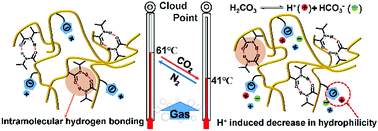A polyelectrolyte-containing copolymer with a gas-switchable lower critical solution temperature-type phase transition†
Abstract
A thermo-responsive copolymer with a gas-switchable LCST-type phase transition was synthesized by reversible addition–fragmentation chain transfer (RAFT) polymerization of N-isopropylacrylamide (NIPAM) and glycidyl methacrylate (GMA), followed by post-polymerization functionalization with sodium 3-amino-1,2,4-triazole (ATANa). Incorporating ionic moieties provides an elevated cloud point of 61 °C. Importantly, both CO2 and SO2 cause a reduction in the cloud point of the polymer solution. The CO2-triggered system can be easily and fully recovered to its initial state by introducing an inert gas (e.g. N2), whereas the SO2-triggered system shows only partial recovery. The pH-dependent phase transition behaviors confirm that the gas bubbling-induced pH changes contribute to the gas-switchable cloud point of P(NIPAM-co-(GMA-ATANa)). In addition, P(NIPAM-co-(GMA-ATA)) (ATA: 3-amino-1,2,4-triazole), a counterpart of P(NIPAM-co-(GMA-ATANa)), was prepared and the relevant solution phase transition behavior was studied. Its cloud point shift in response to gas bubbling and pH adjustment is opposite to that of P(NIPAM-co-(GMA-ATANa)), indicating that the latter does not result from the protonation of amidine groups. Alternatively, a reversible H+-induced decrease in hydrophilicity was thus proposed. This contribution enriches the family of thermo-responsive polymers by introducing gas-sensitive polyelectrolytes and also broadens the scope of gas-responsive smart materials.



 Please wait while we load your content...
Please wait while we load your content...